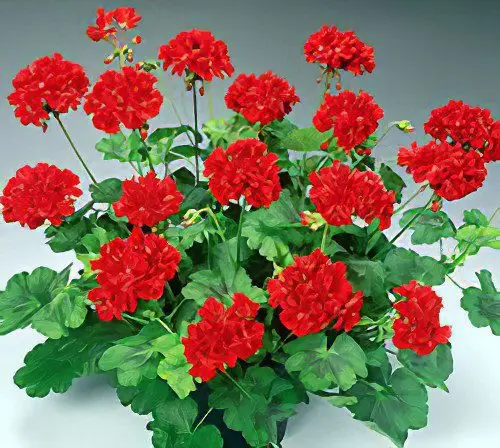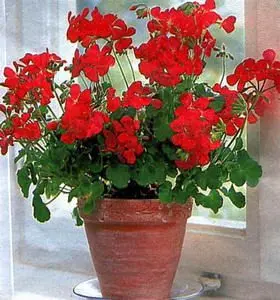Contents
Cultivation, medicinal properties and use of geranium oil
Geranium room
Geranium is the most famous houseplant. This plant is easy to care for and propagate it will not be difficult. There are many varieties and types of geraniums.
Geranium is an annual and perennial plant with stems about 50 cm high. The leaves of the plant are a bright dark green color. Geranium flowers are very beautiful and large, in some species they are collected in inflorescences. And geranium leaves have a refreshing, mint and lemon scent. The leaves have a pattern, which is in the form of a white border or stripes of various colors.
And now geranium is the most favorite indoor plant among the rest. In almost every family on the windowsill you can see this beautiful, unpretentious, hardy flower.
Geranium also grows wild. It can be seen in the meadows of the Caucasus and Europe, in the southern mountains. Almost all types of geraniums have an average moisture requirement. In order for geranium to grow normally, it needs constant watering and loosening of the soil. The best soils for geraniums are acidic, neutral and slightly acidic soils. The main condition for the growth of each type of geranium (except marsh) is the absence of stagnant water. Geraniums are frost resistant.
Geranium blooms very beautifully. Umbrellas of flowers are located on a thin stem, and the leaves are very similar to a human palm. If the geranium has little light, it will reduce its flowering itself, and the flowers and leaves will become faded.
Geranium care and reproduction
Care. In order for geraniums to grow well, you need to create the right flower garden. And only in this case, dense geranium bushes will not allow weeds to grow. In May – before mass leaves appear – weeding of geranium flower beds should be done. Also in May, you need to loosen the soil, add fertilizer to it, you can also add ash. Further care is regular watering. When the flowers begin to fade, be sure to cut off the faded shoots. Geraniums, in which the leaves do not hibernate, need to cut off the above-ground shoots in September. Some types of geraniums need garters.
Breeding. Geranium reproduces in two ways: vegetatively and by seeds. Each species bears fruit well. When the fruits ripen, the seeds spread throughout the field, which makes it difficult to collect the seeds. If the seeds are harvested in August, then they can be sown immediately in the ground (in this case, the seeds will have time to form seedlings before the start of frost). However, the best time to plant seeds is winter, because that’s when the soil has already experienced frost. In May, many shoots will appear, and after a year you can see seedlings.
Quickly appeared seedlings must first be planted in a nursery. When the bush is already fully formed, it can be transplanted into a flower garden with a distance of 40 cm from bush to bush.
But still, the simplest and easiest way to grow geraniums is to divide the bush. This method is the most successful for varietal geraniums. The division of the bush is carried out either at the beginning of spring or at the end of summer (the second option is most suitable). In summer, it is much easier for a plant to shake off the roots from the soil and calmly plant it in another place. The gardener should look at the renewal buds, because if they are loose, rotten and parched, then a transplant is not necessary. During September, young roots will form on the plots (they will overwinter with the plant). Many geraniums, with a few exceptions (Robert’s geranium and others), are perennials. If the bush is not transplanted and does not divide, then it can please the gardener in the flower garden for about 12 years. And after 12 years, the geranium will show signs of aging, for example, dead parts will appear in the center of the bush. Therefore, without waiting for the aging of the plant, it is better to divide the bush 10 years after planting and transplant it to a new place.
The benefits of geranium
Geranium has a lot of useful properties for humans. For example, a plant releases bactericidal substances into the air. And these substances destroy various types of microbes, including staphylococcus aureus.
For medicinal purposes, use grass, flowers, roots and leaves of geranium. Preparations from this plant contain gallic acid, starch, pectin, tannins and gum, due to which they have a tightening effect on the human body. Geranium is an obstacle to the secretion of fluids in the body. The plant is used for pharyngitis, nose and other bleeding as a hemostatic agent.
Geranium helps to get rid of insomnia, relieve fatigue, normalize the nervous system. Geranium tea is taken in case of bowel disorder or dysentery.
Geranium Essential Oil

Taking the leaves of perennial geranium, geranium essential oil is obtained by steam distillation. The aroma of the oil is oily, warm, floral, slightly reminiscent of the aroma of a rose. The essential oil is light and fluid, colorless. Geranium treats inflammation of the ear, nose and throat, which is why it was called the “ear-nose-throat doctor” in the old days.
Geranium essential oil is a real antidepressant. It increases physical and even mental activity, relieves a person of feelings of inferiority. Geranium oil restores the skin after getting burns, various kinds of frostbite. They can treat rashes and dry eczema.
The oil has a property that normalizes blood microcirculation in the heart and blood pressure. It is used as a strong pain reliever. And also essential oil is successfully used to eliminate neuritis, radicular syndrome and neuralgia.
Geranium – oil for women! This is true, because this oil normalizes the hormonal process in the body, helps with premenstrual syndrome, relieves pain during menstruation. The oil also relieves depression. The same oil is used for inflammation of the mammary glands.
Geranium oil should not be used for more than 14-20 days. Never use it on an empty stomach!
Geranium diseases
Rarely, but still, geranium suffers from brown spotting and powdery mildew. So that the plant does not suffer from powdery mildew, it must be cut off after the flowering period (due to this, the new shoots will be stronger than the old ones). If the plant is sick with brown spotting, then you need to cut off the diseased leaves and burn them. Fungal diseases do not have a strong effect on the state of the plant itself.
Geranium treatment

Due to its enormous healing abilities, geranium is very often used in folk medicine. An infusion of the leaves of the plant helps with sore throat. A geranium compress is applied for osteochondrosis and sciatica. Geranium helps to cope with diseases of the gastrointestinal tract and heart.
A decoction of herbs and geranium roots. He prepares easily. We take 1 tablespoon of dried geranium, pour 200 ml of boiling water and put on fire for 5 minutes. Then we cool everything and filter. The resulting volume of the broth must be brought to the original by adding boiling water. It is recommended to use the remedy 1-2 tablespoons at the time of eating 3 times a day. This decoction is taken for inflammation of the upper respiratory tract.
Geranium juice for cataracts. If the cataract is at the initial stage, then geranium will help here. To do this, you just need to drip 1 drop of geranium juice into the corner of your eye every day. This juice will not only preserve, but also improve vision for many years to come. With suppuration and clouding of the eyes, this juice will also come to the rescue.
Honey water with geranium. If the eyelids become inflamed with this water, you should wash your eyes early in the morning and in the evening. It is very easy to cook it. To do this, take 10 pieces of geranium leaves and grind them. Next, take a glass of water and pour the leaves, add 1 teaspoon of honey to them. We mix everything well and leave it overnight on a full moon – so that the light from the moon is on the glass. With this water, we wash the eyes with inflamed eyelids.
Treatment of geranium otitis media
Otitis in both adults and children will help cure geranium. To do this, take 5-10 grams of geranium leaves, and mash them into a soft gruel. Now here we add 40-60 grams of flour (rye or oatmeal) and 1 tablespoon of camphor alcohol. Next, you need to knead the steep dough, roll it up with a roller and wrap it around the ear from the outside. And inside the ear you need to drip 1 or 2 drops of geranium juice. Next, the ear should be covered with compress paper and insulated with cotton wool. At night, do not forget to fix the compress with a bandage. And after three or four such light procedures, you will forget about the sore ear.
Contraindications to the use of geranium
Pregnant women should not take geranium, in whatever form it may be. Also, geranium is forbidden to be taken if there are chronic diseases. Geranium is contraindicated for the elderly.









